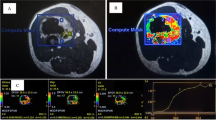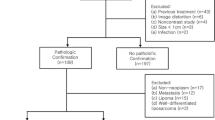Abstract
Objectives
To evaluate the added value of DWI, qualitative proton MR spectroscopy (H-MRS) and dynamic contrast-enhanced perfusion (DCE-P) to conventional MRI in differentiating benign and malignant non-fatty soft tissue tumors (NFSTT).
Methods
From November 2009 to August 2017, 288 patients with NFSTT that underwent conventional and advanced MRI were prospectively evaluated. The study was approved by the local ethics committee. All patients signed an informed consent. A musculoskeletal (R1) and a general (R2) radiologist classified all tumors as benign, malignant, or indeterminate according to morphologic MRI features. Then, DWI, H-MRS, and DCE-P data of indeterminate tumors were analyzed by two additional radiologists (R3 and R4). Advanced techniques were considered individually and in combination for tumor benign-malignant differentiation using histology as the gold standard.
Results
There were 104 (36.1%) malignant and 184 (63.9%) benign tumors. Conventional MRI analysis classified 99 tumors for R1 and 135 for R2 as benign or malignant, an accuracy for the identification of malignancy of 87.9% for R1 and 83.7% for R2, respectively. There were 189 indeterminate tumors for R1. For these tumors, the combination of DWI and H-MRS yielded the best accuracy for malignancy identification (77.4%). DWI alone provided the best sensitivity (91.8%) while the combination of DCE-P, DWI, and H-MRS yielded the best specificity (100%). The reproducibility of the advanced imaging parameters was considered good to excellent (Kappa and ICC > 0.86). An advanced MRI evidence-based evaluation algorithm was proposed allowing to characterize 28.1 to 30.1% of indeterminate non-myxoid tumors.
Conclusion
The prioritized use of advanced MRI techniques allowed to decrease by about 30% the number of non-myxoid NFSTT deemed indeterminate after conventional MRI analysis alone.
Key Points
• When morphological characterization of non-fatty soft tissue tumors is possible, the diagnostic performance is high and there is no need for advanced imaging techniques.
• Following morphologic analysis, advanced MRI techniques reduced by about 30% the number of non-myxoid indeterminate tumors.
• DWI is the keystone of advanced imaging techniques yielding the best sensitivity (91.8%). Optimal specificity (> 90%) is obtained by a combination of advanced techniques.






Similar content being viewed by others
Abbreviations
- CHAID:
-
Chi-squared automatic interaction detector
- DCE-P:
-
Dynamic contrast-enhanced perfusion
- DWI:
-
Diffusion-weighted imaging
- H-MRS:
-
Magnetic resonance spectroscopy
- NFSTT:
-
Non-fatty soft tissue tumor
- R1/2/3/4:
-
Reader 1/2/3/4
References
Kransdorf MJ, Murphey MD (2000) Radiologic evaluation of soft-tissue masses: a current perspective. AJR Am J Roentgenol 175(3):575–587
Wu JS, Hochman MG (2009) Soft-tissue tumors and tumorlike lesions: a systematic imaging approach. Radiology 253(2):297–316
De Schepper AM, De Beuckeleer L, Vandevenne J, Somville J (2000) Magnetic resonance imaging of soft tissue tumors. Eur Radiol 10(2):213–223
Gielen JLMA, De Schepper AM, Vanhoenacker F et al (2004) Accuracy of MRI in characterization of soft tissue tumors and tumor-like lesions. A prospective study in 548 patients. Eur Radiol 14(12):2320–2330
Tedesco NS, Henshaw RM (2016) Unplanned resection of sarcoma. J Am Acad Orthop Surg 24(3):150–159
Gondim Teixeira PA, Gay F, Chen B et al (2016) Diffusion-weighted magnetic resonance imaging for the initial characterization of non-fatty soft tissue tumors: correlation between T2 signal intensity and ADC values. Skeletal Radiol 45(2):263–271
Gondim Teixeira PA, Ledrich M, Kauffmann F et al (2017) Qualitative 3-T proton MR spectroscopy for the characterization of musculoskeletal neoplasms: update on diagnostic performance and indications. AJR Am J Roentgenol 208(6):1312–1319
Leplat C, Hossu G, Chen B et al (2018) Contrast-enhanced 3-T perfusion MRI with quantitative analysis for the characterization of musculoskeletal tumors: is it worth the trouble? AJR Am J Roentgenol 211(5):1092–1098
Bonarelli C, Gondim Teixeira PA, Hossu G et al (2015) Impact of ROI positioning and lesion morphology on apparent diffusion coefficient analysis for the differentiation between benign and malignant nonfatty soft-tissue lesions. AJR Am J Roentgenol 205(1):W106–W113
van Rijswijk CSP, Geirnaerdt MJA, Hogendoorn PCW et al (2004) Soft-tissue tumors: value of static and dynamic gadopentetate dimeglumine-enhanced MR imaging in prediction of malignancy. Radiology 233(2):493–502
Choi YJ, Lee IS, Song YS, Kim JI, Choi K-U, Song JW (2019) Diagnostic performance of diffusion-weighted (DWI) and dynamic contrast-enhanced (DCE) MRI for the differentiation of benign from malignant soft-tissue tumors. J Magn Reson Imaging 50(3):798–809
van Rijswijk CSP, Kunz P, Hogendoorn PCW, Taminiau AHM, Doornbos J, Bloem JL (2002) Diffusion-weighted MRI in the characterization of soft-tissue tumors. J Magn Reson Imaging 15(3):302–307
Costa FM, Martins PH, Canella C, Lopes FPPL (2018) Multiparametric MR imaging of soft tissue tumors and Pseudotumors. Magn Reson Imaging Clin N Am 26(4):543–558
Subhawong TK, Wang X, Durand DJ et al (2012) Proton MR spectroscopy in metabolic assessment of musculoskeletal lesions. AJR Am J Roentgenol 198(1):162–172
Jeon JY, Chung HW, Lee MH, Lee SH, Shin MJ (2016) Usefulness of diffusion-weighted MR imaging for differentiating between benign and malignant superficial soft tissue tumours and tumour-like lesions. Br J Radiol 89(1060):20150929
Yoon MA, Chee CG, Chung HW et al (2019) Added value of diffusion-weighted imaging to conventional MRI for predicting fascial involvement of soft tissue sarcomas. Eur Radiol. https://doi.org/10.1007/s00330-018-5786-3
Hong JH, Jee WH, Jung CK, Jung JY, Shin SH, Chung YG (2019) Soft tissue sarcoma: adding diffusion-weighted imaging improves MR imaging evaluation of tumor margin infiltration. Eur Radiol 29(5):2589–2597
Hirschmann A, van Praag VM, Haas RL, van de Sande MAJ, Bloem JL (2020) Can we use MRI to detect clinically silent recurrent soft-tissue sarcoma? Eur Radiol. https://doi.org/10.1007/s00330-020-06810-z
Chhabra A, Ashikyan O, Slepicka C et al (2019) Conventional MR and diffusion-weighted imaging of musculoskeletal soft tissue. Correlation With Histologic Grading. Eur Radiol 29(8):4485–4494. https://doi.org/10.1007/s00330-018-5845-9
Lee JH, Yoon YC, Seo SW, Choi YL, Kim HS (2020) K. Soft tissue sarcoma: DWI and DCE-MRI parameters correlate with Ki-67 labeling index. Eur Radiol. https://doi.org/10.1007/s00330-019-06445-9
Nagata S, Nishimura H, Uchida M et al (2008) Diffusion-weighted imaging of soft tissue tumors: usefulness of the apparent diffusion coefficient for differential diagnosis. Radiat Med 26(5):287–295
Tuncbilek N, Karakas HM, Okten OO (2005) Dynamic contrast enhanced MRI in the differential diagnosis of soft tissue tumors. Eur J Radiol 53(3):500–505
Del Grande F, Ahlawat S, Subhawong T, Fayad LM (2017) Characterization of indeterminate soft tissue masses referred for biopsy: what is the added value of contrast imaging at 3.0 Tesla? J Magn Reson Imaging 45(2):390–400
Demehri S, Belzberg A, Blakeley J, Fayad LM (2014) Conventional and functional MR imaging of peripheral nerve sheath tumors: initial experience. AJNR Am J Neuroradiol 35(8):1615–1620
Papp DF, Khanna AJ, McCarthy EF, Carrino JA, Farber AJ, Frassica FJ (2007) Magnetic resonance imaging of soft-tissue tumors: determinate and indeterminate lesions. J Bone Joint Surg Am 89(Suppl 3):103–115
Gondim Teixeira PA, Leplat C, Chen B et al (2017)Contrast-enhanced 3T MR perfusion of musculoskeletal tumours: T1 value heterogeneity assessment and evaluation of the influence of T1 estimation methods on quantitative parameters. Eur Radiol 27(12):4903–4912
De Schepper AM, Ramon FA, Degryse HR (1992) Statistical analysis of MRI parameters predicting malignancy in 141 soft tissue masses. Rofo 156(6):587–591
Chung WJ, Chung HW, Shin MJ et al (2012) MRI to differentiate benign from malignant soft-tissue tumours of the extremities: a simplified systematic imaging approach using depth, size and heterogeneity of signal intensity. Br J Radiol 85(1018):e831–e836
Berquist TH, Ehman RL, King BF, Hodgman CG, Ilstrup DM (1990) Value of MR imaging in differentiating benign from malignant soft-tissue masses: study of 95 lesions. AJR Am J Roentgenol 155(6):1251–1255
Moulton JS, Blebea JS, Dunco DM, Braley SE, Bisset GS, Emery KH (1995) MR imaging of soft-tissue masses: diagnostic efficacy and value of distinguishing between benign and malignant lesions. AJR Am J Roentgenol 164(5):1191–1199
Petscavage-Thomas JM, Walker EA, Logie CI, Clarke LE, Duryea DM, Murphey MD (2014) Soft-tissue myxomatous lesions: review of salient imaging features with pathologic comparison. Radiographics 34(4):964–980
Nakamura T, Matsumine A, Matsubara T, Asanuma K, Uchida A, Sudo A (2011) The symptom-to-diagnosis delay in soft tissue sarcoma influence the overall survival and the development of distant metastasis. J Surg Oncol 104(7):771–775
Murray D, Topfer J, Decilveo AP, Wittig JC (2016) Benefits associated with early diagnosis and treatment of soft tissue sarcomas of the foot and ankle. J Foot Ankle Surg 55(5):980–984
Song Y, Yoon YC, Chong Y et al (2017) Diagnostic performance of conventional MRI parameters and apparent diffusion coefficient values in differentiating between benign and malignant soft-tissue tumours. Clin Radiol 72(8):691.e1–691.e10
Gondim Teixeira PA, Hossu G, Kauffmann F et al (2014) Influence of calcium on choline measurements by 1H MR spectroscopy of thigh muscles. Eur Radiol 24:1309–1319
Wu H, Zhang S, Liang C et al (2017) Intravoxel incoherent motion MRI for the differentiation of benign, intermediate, and malignant solid soft-tissue tumors. J Magn Reson Imaging 46(6):1611–1618
Gillies RJ, Kinahan PE, Hricak H (2016) Radiomics: images are more than pictures, they are data. Radiology 278(2):563–577
Bonekamp D, Kohl S, Wiesenfarth M et al (2018) Radiomic machine learning for characterization of prostate lesions with MRI: comparison to ADC values. Radiology 289(1):128–137
Wang H, Nie P, Wang Y et al (2020) Radiomics nomogram for differentiating between benign and malignant soft-tissue masses of the extremities. J Magn Reson Imaging 51(1):155–163
Crombe A, Alberti N, Stoeckle E et al (2016) Soft tissue masses with myxoid stroma: can conventional magnetic resonance imaging differentiate benign from malignant tumors? Eur J Radiol 85(10):1875–1882
Funding
The authors state that this work has not received any funding.
Author information
Authors and Affiliations
Corresponding author
Ethics declarations
Guarantor
The scientific guarantor of this publication is Pr Pedro Augusto GONDIM TEIXEIRA.
Conflict of interest
The authors of this manuscript declare no relationships with any companies whose products or services may be related to the subject matter of the article.
Statistics and biometry
One of the authors has significant statistical expertise.
Informed consent
Written informed consent was obtained from all subjects (patients) in this study.
Written informed consent was waived by the Institutional Review Board.
Ethical approval
Institutional Review Board approval was obtained.
Study subjects or cohorts overlap
Some study subjects have been previously reported in prior studies in our institution.
Methodology
• prospective
• diagnostic study
• performed at one institution
Additional information
Publisher’s note
Springer Nature remains neutral with regard to jurisdictional claims in published maps and institutional affiliations.
Electronic supplementary material
ESM 1
(DOCX 3031 kb)
Rights and permissions
About this article
Cite this article
Dodin, G., Salleron, J., Jendoubi, S. et al. Added-value of advanced magnetic resonance imaging to conventional morphologic analysis for the differentiation between benign and malignant non-fatty soft-tissue tumors. Eur Radiol 31, 1536–1547 (2021). https://doi.org/10.1007/s00330-020-07190-0
Received:
Revised:
Accepted:
Published:
Issue Date:
DOI: https://doi.org/10.1007/s00330-020-07190-0




